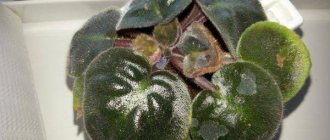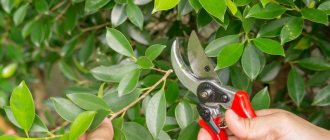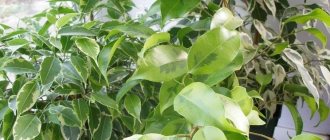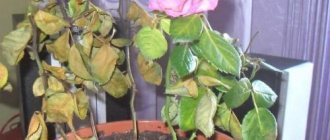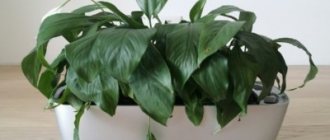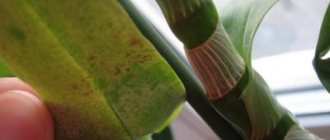More than 50 species of this crop are used in indoor floriculture! You can choose a plant that is compact or tall, of different types of growth, with wide large glossy or thin small leaves, with different colors, shapes and sizes of leaf blades on short or long petioles...
But it’s not always that a bright bush with a dense crown brought from a store or greenhouse will feel good in a new place. Thus, many owners of one of the most popular types of ficus, Ficus Benjamin, complain that their leaves “slightly” turn yellow and fall off en masse. Owners of ficuses with hard, leathery leaves (rubber, microcarpa, etc.) sometimes notice that they begin to lose turgor, wither or dry out at the edges and tips. Sometimes the problem does not end with darkening and flying leaves - then the branches and even the ficus stem dry out.
What troubles and why can happen to your favorite indoor plant? And most importantly, how to eliminate their causes and return the ficus tree to its former decorative properties? Let's figure out together why the ficus dries out or flies around in the apartment.
Reason #1. Abrupt change in conditions
Some ficus plants are simply very capricious in terms of changing growing conditions.
Of course, each type of ficus has its own requirements for living conditions, but there are also “record holders for capriciousness.” The main “picky” plant in this regard is the already mentioned Ficus Benjamin, which reacts with massive leaf fall to literally any changes.
Ficus growers even joke about this: “If you bought a Benjamin ficus, then you don’t need to ask whether it will shed leaves in your apartment, you need to ask exactly when and how quickly it will do it.”
The light from the window became brighter in the spring, or you opened the window wide, turned the radiators on or off (changing the air humidity), in the fall it became cooler in the apartment, the child carelessly touched the plant while watering, or you moved the pot to a nearby window sill for convenience - and here is a tree, which just pleased you with its lush openwork crown of variegated leaves, stands almost bald.
The same demanding ficuses include ficus sacred, ficus rough, ficus equifolia, ficus Palmer, ficus microcarpa.
In most cases, having become a little angry at the careless owners and being left alone, such a plant will soon grow into foliage again. But not always.
So if you are the owner of an apartment where the windows are constantly open and there is a draft, children and animals run around, touching the plants, you often forget to water indoor flowers on time or regularly rearrange them around the room - maybe you just need to replace the “whims” with more unpretentious ones and resistant to change representatives of the clan? For example, rubber ficus, lyre-shaped ficus, willow ficus.
Care problems
To avoid any difficulties in the future, it is necessary to carry out a careful inspection at the time of purchase.
Carefully examine the leaves, twigs, and soil for pests and diseases.
The leaves should be elastic, rich green in color without visible damage or defects, and the whole plant as a whole should have a healthy appearance.
If there are spots on the foliage, small rashes, or any other visible imperfections, most likely this flower is sick and can infect other indoor plants.
At first, keep the newly purchased flower separately from other plants. This is necessary in order to identify possible problems. After a month or two, if no pests or diseases have appeared, it can be placed near other flowers.
Diseases can occur in the event of the following care errors:
- temperature imbalance;
- excess or deficiency of air humidity;
- untimely or frequent watering;
- lack or oversaturation of essential microelements.
The leaves are turning yellow, what should I do?
The leaves may take on a characteristic yellow tint in several cases. The first reason is most often that the air in the room is too dry. This problem often manifests itself in the summer with the onset of heat and during the heating season, when using heating devices. In this case, the foliage gradually fades and falls off.
Another reason for yellowing leaves is burns caused by direct sunlight.
How to save a plant from this?
- In summer, the flower should not be exposed to direct sunlight for a long time.
- In winter, it is better to relocate it to places far from the batteries.
To humidify the air, use a container of water near the plant.
Spots on leaves
If freckles appear on the leaves in the form of yellow or brown spots or the edges begin to take on a sandy tint, this is most likely a consequence of waterlogging in the soil. These symptoms indicate an excess of moisture in the soil and possible rotting of the root system.
Sometimes the leaves turn black around the edges. This is usually also caused by waterlogging of the soil, as well as low temperatures and drafts.
It is urgent to dry the soil and review the watering rules. Ficus does not tolerate stagnation of water in the pan. Drafts and, in general, any sudden change of environment are harmful to him.
Ficus doesn't grow
The following external symptom can also indicate a problem with the soil: the leaves begin to grow smaller and smaller and eventually the ficus stops growing altogether. Most often this occurs due to soil depletion. When the moment comes that the soil is depleted of all useful resources, the recently blossomed ficus leaves begin to gradually become smaller in mineral components, and their predecessors turn yellow, wither and fall off.
To return the plant to normal functioning, it is necessary to replant it or replace the soil. The substrate must be saturated with the necessary mineral complex and vitamins. Stores now sell soil specially prepared for ficus.
It will also be good to fertilize the ficus. It is best to use complex fertilizer.
Attention! An excess of nutrients can also negatively affect the general condition of the indoor occupant, so it must be used strictly according to the instructions.
Ficus can stop growing even if it does not have enough lighting.
Why does ficus shed its leaves?
The main reason for dropping leaves is overdried soil or watering with poor quality water. If a ficus sheds its leaves due to a lack of water, then its root system is also not in the best condition, because it is directly related to nutrition and water balance. In this case, you need to water it generously and subsequently monitor the quality and frequency of watering.
Ficus tree varieties tend to lose the leaves of the lower part of the trunk, but this is not a disease. In general, the bush itself never becomes bare, but on the contrary produces more and more new leaves.
Ficus leaves may fall off in other cases. The flower is either affected by an infection or by some pest. In such cases, treatment with special preparations is necessary.
Reason #2. Heat and dryness
This is perhaps the most obvious reason why ficus leaves can dry out.
Most representatives of this genus require a fairly cool ambient temperature (especially in winter, and usually not higher than 20-25°C in summer), constantly moderately moist soil, and mandatory regular spraying of the crown or wiping the leaves with a soft damp cloth.
Ficus small-fruited, ficus lyre-shaped, rubber-bearing ficus, ficus natalis, ficus sagitta, ficus microcarpa, ficus dwarf are in great need of humidity “from above and below”, as well as in the absence of dry heat.
Direct sunlight, dry air and soil, underwatering, placement near heating sources in winter - all this is almost guaranteed to lead to withering and drying out of the leaves and young shoots of such plants. In this case, leaf blades often begin to dry from the edges or tips.
Why do ficus trees get sick?
First of all, improper maintenance conditions lead to withering:
- strong changes in air temperature in the room, or its constant overestimation,
- dry air, drafts,
- insufficient or, conversely, too bright lighting,
- inconsistency with the watering regime: too frequent or, on the contrary, insufficient,
- improper mineralization,
- contaminated soil.
Having corrected these shortcomings, the ficus will quickly return to normal and reward it with bright colors.
But some diseases are caused by more serious reasons: ficus can be attacked by fungal diseases and pests, photos of which will be given below. They require more attention and time, and in some cases, disposal of the flower.
Yellowing
Reason: the air in the room is not humid enough, the air is too warm, or the lighting is too bright. This happens more often during the heating season, or when the ficus is standing on a windowsill on the south side - the sun's rays burn it, it turns yellow and begins to fade.
How to fix it: remove it from the heater or sun, humidify the air, for this you can use a humidifier, or a moistened towel that is hung on the radiator. As it dries, the procedure is repeated. Spraying the leaves more frequently will help.
Important! You cannot spray the ficus by leaving it in the sun; water and rays can cause severe burns, leading to death. Frequent changes in location can cause yellowing.
The flower does not have time to adapt; it “speaks” about its well-being with its appearance. You need to immediately determine its place in the house, taking into account the convenience of the owners and the new resident himself.
Frequent changes of location can provoke yellowing. The flower does not have time to adapt; it “speaks” about its well-being with its appearance. You need to immediately determine its place in the house, taking into account the convenience of the owners and the new resident himself.
They become small and fall off
- There are not enough nutrients: replanting into a new, correctly combined soil will help: peat, leaf soil, sand are mixed in equal proportions. After transplanting, water.
- Excess moisture: this will be indicated by spots on the leaves, yellow edges and falling off. You need to wait with the next watering until the soil dries completely, then continue watering moderately. If the leaves begin to fall off significantly, immediate replanting is necessary, and the rotten roots of the plant must be removed.
It is important not to forget that rare watering will also affect the condition of the leaves - they will wrinkle and dry out. If this is not corrected in time, the roots will dry out, which will be impossible to correct.
High temperature, dry air, excessive feeding:
Brown spots form on the leaves. This can be corrected by eliminating the cause.
Reason #3. Overflow
You may be surprised, but for ficus plants with thin leaf blades, overwatering can be just as unpleasant as underwatering!
The same ficus Benjamin, equal-leaved, sacred, dwarf and even rubber-bearing ones will persistently “demand” stable humidity from the owner. Do you transfuse regularly? Got dampness in the pot? Did you pour water at the wrong temperature? Receive yellowing, darkening and leaf drop.
Regular overwatering can even lead to rotting of the roots - you understand, the above-ground part of the plant after this is unlikely to be healthy and decorative, the leaves will begin to wither and fall off.
But, for example, the wall ficus is not so capricious - at least it will tolerate a single severe drought or waterlogging without much damage to itself.
There are also ficuses that require completely different conditions at different times of the year. So, figs (yes, this is also a ficus, though it is deciduous!) in the summer during the growing season will require abundant watering from you, but in the winter during the dormant period it will require very, very moderate watering, as long as the soil does not turn into stone or dry dust.
Meet Ficus Benjamin
This is an evergreen plant, common in the subtropics and humid tropics of Asia: India, Indonesia, the Philippines, Malaysia. In the homeland of this ficus there are specimens more than 40 m in height and about 5 m in width.
At home, the maximum height of ficus Benjamin is 1.5 - 2.0 m. The reason for this is the unsuitable conditions of our apartments.
And yet, over several centuries of cultivation, Benjamin learned to adapt to home conditions. Why do crashes happen?
Reason #4. Light too bright or dim
As we have already mentioned, some ficus plants are exclusively shade-loving plants. Being suddenly exposed to direct sun or constantly being on the brightest windowsills, they will feel unwell, responding to this “attitude” towards themselves, including discoloration and drying out of the leaf blades, and even getting real sunburn.
Such plants include, for example, ficus sacred and ficus wall. The rubber ficus also adapts well to lighting.
But figs, ficus Benjamin, ficus lyreform, ficus microcarpa, rubber ficus, petiolate ficus, dwarf ficus, ficus binnendijka (willow leaf), on the contrary, love “stable” light places - but for them, light, even bright and plentiful, will be more acceptable, but scattered, not direct. In these species, on the contrary, it is excessive darkening that can cause the leaf blades to darken and fall off (usually starting from the lower ones).
- Ornamental plants for a shady balcony: list with photos Plants for shady places can be no less decorative and bright than light-loving crops.
How to save ficus
How to revive a ficus that has begun to rapidly lose leaves? This process begins due to many reasons: a sudden change of location, draft, cold and errors in care, or even lack of care. With a regular lack of lighting, too dry air or waterlogging, “leaf fall” and rapid death of the plant will not take long, so measures should be taken immediately.
If the leaf falls off in large quantities, the first step is to spray the Benjamin ficus with the maintenance drug Epin. Restoring the viability of a plant directly depends on the reasons that caused its disease. Sometimes it is possible to restore the beauty and healthy appearance of a rubber plant with the help of basic measures, without even resorting to scrupulous replanting and lengthy processing.
The main conditions for the normal life of a tree are diffused light, moderate and timely watering, air humidity from 50 to 70 percent and spraying. The soil should dry out a little between water procedures, and the need for watering can be easily determined by checking the condition of the soil in the pot. If its top layer has dried out a little (by two to three centimeters), it’s time to water the ficus. You cannot frequently move the pot from place to place, as this will cause leaf fall to become regular, and it may happen that the plant completely loses its foliage, without even suffering from fungal diseases.
The scorching sun is contraindicated for ficus plants. It would be a mistake to believe that if we are talking about a tropical plant, then it will not care about sunlight. The foliage of most rubber plants is dense and thick, which means it contains a sufficient amount of moisture (which cannot be said about tenacious cacti) and will suffer from its lack.
If a gardener gets a tree with a classic, dark green foliage color, such varieties are more unpretentious in care and can acclimatize well even under conditions of regular shading. As for bright variegated leaves, the situation with them is much more complicated: they are capricious, and if the owner does not pay special attention to them, they can quickly die. Variegated varieties are especially sensitive to lack of lighting: they can wither even if they are placed in the shade for a short time.
Air temperature is no less important. In summer, its optimal values are from +25 to 30C, and if it rises, the plant should not only be watered and shaded, but also sprayed. Heat can also cause leaf drying and subsequent rubber disease. In the cold season, the roots should not be allowed to overcool. If possible, it is better to place the pot on a stand or windowsill, wrapping it in a warm cloth. The room temperature should not be allowed to drop below +15C.
This is interesting: Planting garlic. When is the best time to plant
So, the issue of resuscitating a fading pet can be resolved by following the usual and simple measures to care for it, as well as choosing a permanent and most suitable growing location, with diffused light and the absence of drafts.
Optimal conditions for ficus resuscitation
The tree can also be removed in more severe cases. It also happens that, due to total leaf fall, only the trunk remains. It is necessary to check how much vitality is still left in it: if it remains flexible and has not had time to dry out, there is a chance to save the rubber plant. If rot and plaque appears on the soil in the root zone of the trunk, you should also not despair: this will require immediate replanting with a scrupulous examination of the root system for damage by nematode pests.
If there are small light lumps on the roots, this is the result of parasite activity. Treating the roots with insecticides and disinfectants will help. An ordinary weak solution of potassium permanganate helps a lot.
The wilting of a tree can be caused by the intensive growth of its root system, which simply no longer fits into the previous container. A transplant will also help here, and the new container should be two to three centimeters larger than the previous one. There is no need to use a pot that is too large.
After transplanting, regular watering will be required, but not earlier than after two days. Fertilizing is carried out only after reliable rooting, after a month. As for the intensity of leaf fall, in autumn, a loss of about twenty percent is the norm, and it is not associated with any diseases or errors in care.
A typical mistake of a gardener who wants to revive a ficus is the desire to feed it as much as possible. This cannot be done, since a weakened plant is simply not able to absorb the complex substances contained in mineral fertilizers, and they will only harm it.
Experienced plant growers on numerous forums are happy to share their experience of caring for the most “difficult” patients among the ficus plants they received. In their practice, there are cases when they had to deal with an almost flown-off flower, on which no more than five leaves remained. For the dried out plant, the soil was completely changed to a suitable nutrient composition and the roots were washed in a manganese solution.
If there were signs of rotting, the diseased roots were removed with sharp pruning shears and sprinkled with wood ash. After transplantation, they added a little fertilizer, placed the flower in a suitable place and shaded it so that the bright sun did not shine on it. Of course, the watering and spraying scheme was adjusted. In most cases, “neglected” rubber plants came to life after a few weeks and began to produce new healthy leaves.
As practice shows, it is quite possible to revive a ficus - even in a very “neglected” state, but in order not to resort to such measures, it is best to properly care for it and take care of it. Then he will not get sick and will always delight the owner with his healthy appearance.
Reason #5. Cold
Remember - comfortable, cool conditions for growing ficus trees do not at all equal the concept of “needing cold.”
Even the most shade-tolerant and heat-averse ficus plants will react to hypothermia of the roots, including drying out and falling leaves. This is especially dangerous when coupled with regular overwatering, when the roots not only get too cold, but also begin to rot. And such hypothermia, for example, can occur already at temperatures below 16-18°C.
This may also be relevant for potted crops that stand on a cold (for example, stone) floor or windowsill, where drafts are frequent. An option to correct this situation is to place a felt, wooden or foam “backing” under the ficus pot.
In any case, before purchasing this or that ficus, be sure to study its requirements for living conditions - including temperature!
Reason #6. Soil depletion
Ficus foliage can weaken, turn yellow, dry out and fall off for another obvious reason - the plant lacks nutrition.
Ficus does not require frequent regular heavy feeding, but any soil becomes depleted over time, so from time to time it would be a good idea to feed this unpretentious plant with liquid complex fertilizer.
Oddly enough, if the tips of the leaves of a plant regularly dry out, the opposite situation is also possible - you are overfeeding it!
It is also possible that the ficus “sits” for years in a small pot without moving it - and it lacks not only fresh nutritious soil, but also, in principle, space for the root system. There can be no talk of good health here.
- How to feed indoor plants - choosing the ideal fertilizers for flowers on the windowsill Do you want your plants to delight you with their healthy appearance all year round? Then create the right feeding regimen for them!
Common ficus diseases
To minimize the damage and quickly get rid of the problem, you need to start treating the flower as early as possible. To do this, you need to know the symptoms of the disease.
Anthracnose
Caused by at least three types of fungi:
- Leaf disease is caused by Colletotrichum orbiculare and Kabatiella zeae;
- It primarily affects the stem of Colletotrichum trichellum.
Favorable conditions are high humidity, temperature above 22° C. Rusty spots with a diameter of 2-12 mm appear on the leaves.
When attacked by the first pest, the center of the area quickly dies, dries out, cracks, and a border is formed along the edge, often quite bright - pinkish, yellowish, with a purple tint. When the disease spreads to the ficus stem, elongated, depressed marks appear on it.
If the causative agent of anthracnose is Kabatiella zeae spores, there is a dark spot in the center of the affected area, surrounded by an off-white rim.
You can tell that a plant is infected with Colletotrichum trichellum by the characteristic appearance of gray pads covered with thin black fibers. This mushroom is especially pronounced on the species Rubber, Lyrata, and others with a thick soft stem.
Sometimes anthracnose disease in ficus plants standing outdoors is mistaken for sunburn, damage from aggressive liquids, or frostbite. In case of unfavorable external influences, there is no border of different color around the affected area, its area does not increase.
If the fight against the disease is not started in a timely manner, the spots grow, the leaves and stems become completely covered with ulcers that secrete a pinkish liquid. The vessels become clogged and the ficus dies.
Treatment is removal of the affected organs. Treatment with fungicides containing copper, Fundazol.
Rust
Fungal disease, causative agent – Uredinalis. Sometimes it is confused with anthracnose; some sources even put the names side by side and claim that they are synonyms. Actually this is not true.
Rust-like pads appear on the underside of the leaves and release spores. Later, yellow or brown convex spots form on the outer part, which in advanced cases merge into stripes and become covered with black dots.
Ficus loses moisture, photosynthesis and metabolism are disrupted, growth slows down, and the leaves dry out. The development of the disease is favored by high humidity at low temperatures and excess nitrogen.
Treatment involves removing diseased and dry leaves and treating with fungicides, for example, copper-containing preparations. At the initial stage of the disease or as a preventive measure, Fitosporin-M will help.
Powdery mildew
It is easily diagnosed, the description corresponds to the name, the causative agent is the Erysiphales fungus. From numerous photographs, the external signs are well known; ficus disease on the leaves manifests itself in the form of a white, flour-like coating. It interferes with photosynthesis and weakens the plant.
The provoking factor is a lack of moisture in the substrate. In the initial stages of the disease, powdery mildew can be washed off with soap and water. Plaque removal in advanced cases is carried out by spraying with fungicides.
Sooty mushroom
Pathogens belong to different genera, their list is huge. The vegetative organs become covered with a black, often sticky coating that can be wiped off with your finger. The disease is easier to detect on ficus plants with large leaves, such as Robusta, than on species or varieties with small leaves.
Feature - mushrooms act as saprophytes, not parasites. That is, they do not invade plants, but feed on dead remains or secretions of other organisms located on them.
This does not mean that the disease can be ignored, and not only because of the reduction in decorativeness:
- leaves covered with plaque stop participating in photosynthesis and redistributing plastic substances;
- in hot summers, black color increases the heating of vegetative organs;
- stomata become clogged;
- the ficus becomes weak, the leaves lose turgor, which increases the likelihood of other infections and makes it easier for pests.
Sooty fungus usually accompanies insect damage. It parasitizes on the products of their vital activity or secretions of an injured plant.
First you need to eliminate the pests, then treat the disease. Wash off the sooty fungus with a soap solution, then treat it with a fungicide. Among the folk remedies, spraying with kerosene works well.
Gray rot
The causative agent is the fungus Botrytis cinerea. The disease is more dangerous for ficuses with loose, late woody trunks, as it often affects not only the leaves, but also the stems.
A prerequisite for infection is the presence of rotting or dead tissue. A healthy plant with intact vegetative organs simply will not get sick. High humidity increases the harmfulness of the fungus.
The first to be affected are the old, lower leaves, from where the infection spreads to the stem. First, brown depressed spots appear, then fluffy gray mycelium grows on them. If the disease has gone far, the ficus sheds its leaves.
Treatment is to remove and destroy the affected plates, reduce watering, increase the frequency and time of ventilation. Treat the tree with fungicides.
Cercospora
The disease occurs against the background of waterlogging, the causative agent is the Cercospora fungus. Black or brown dots appear on the back of the leaves. Over time, they grow and the plates begin to turn yellow. At this stage, it is no longer possible to stop their decline.
Treatment - removal of affected leaves, treatment with fungicides. In an advanced stage, the plant may die.
Root rot
The reason for the appearance of this disease in Ficus Benjamin or other species is systematic overflow. Constant waterlogging causes root rot.
It is almost impossible to avoid this in a wet substrate. Ammonifying (putrefactive) microorganisms are found in water, air and the plants themselves. The disease begins in the process of cell death, subsequent decomposition of protein compounds and amino acids.
Once the root begins to rot, it is no longer able to provide the above-ground part with nutrition and moisture. Most likely, the ficus will have to be thrown away along with the pot.
It can only be saved at the initial stage of the disease; there is only one way to treat it at home - surgically:
- The plant is taken out of the pot.
- The substrate is completely removed.
- Wash the root.
- They clean out the shoots - cut out the rot to living, healthy tissue.
- Treat wounds with crushed activated carbon.
- Leave in the shade for several hours for callus to form.
- Replant into a fresh substrate, a new pot.
- Water the ficus with a solution of Fundazol to prevent the return of root rot due to accidentally missing a diseased area or re-infection.
- Place in the shade for at least a week. At this time, there is no need to water; the leaves are sprayed several times a day.
Even if the root is carefully trimmed, the disease may return and the flower will die. The sooner the owners begin to fight rot, the greater the likelihood of curing the ficus. Recommended topic:
Ficus benjamina leaves turn yellow and fall off: reasons, what to do
Ficus benjamina: methods of propagation at home
How to water ficus correctly and often at home
Fertilizer for ficus: what to feed at home
Ficus does not grow, stands still: reasons, what to do
3 ways to get rid of scale insects on ficus at home
Reason #7. Ficus got sick
Root rot, sooty fungus, cercospora blight, anthracnose, botrytis are diseases that your ficus can “catch” if not properly cared for.
Along with all other signs, the presence of a fungal or bacterial pathogen can also be indicated by dry and weeping spots on the leaves, blackening or yellowing, falling, wilting and drying out of foliage, stems and branches.
To prevent this from happening, study the signs of possible ficus diseases, regularly inspect your plants for their appearance and, if necessary, take appropriate measures - from preventive treatments to plant replanting.
If the plant has shed its clothes
- View the full image
Ficus benjamina leaves falling
- View the full image
General information about ficus
- View the full image
How to help a ficus if the leaves have fallen?
- View the full image
Has your ficus dropped its leaves? Looking for a reason
- View the full image
Useful tips: how to properly care for a plant
- The favorite of gardeners, Ficus Benjamin, is represented by almost every collector of indoor plants. It is loved for its ease of care, excellent decorative properties and the ability to shape both the trunk and the crown. But improper care leads to the fact that the plant completely sheds its foliage and is in danger of moving to the nearest trash heap. But there is no need to rush into this, as there are many ways to help the flower regain its former radiant appearance.
- it has a straight shoot, but the stem is round
- crown, branched
- The leaf blades are smooth, slight bending is allowed. The skin is thin, the leaf is oblong and oval, ending in a pointed tip. The dimensions of the plate are approximately from 5 to 14 cm, its width is from 3 to 7 cm.
- the arrangement of plates on the branches is regular
- petiole from 0.5 to 2 cm.
- the root system is well developed
- gray bark
General information about ficus
There are quite a few varieties of ficus, but the structural features of ficus Benjamin are as follows:
If you initially create good conditions for the plant, then there will be no problems with the plant:
- The ambient temperature must correspond to the climatic season. In winter, ficus is kept at a temperature of 15 to 22 C, in summer 24-29 C.
- Watering must be done as the top soil crust dries. Water from the pan must be removed. The water must be at least 14 C, otherwise the soil will become supercooled and all processes will begin to slow down
- Variegated varieties especially need a good light source
- spraying is carried out only in the absence of drafts and with soft, settled water. You can add special plant sugar or sometimes fungicides to it
Despite the fact that the ficus is not as capricious as many pets that need similar conditions, if not properly cared for, the ficus sheds its leaves and it is quite difficult to restore rich hair later.
There are some factors that directly affect the fact that a plant sheds its leaves:
- The first reason is drafts. Ficus benjamina categorically does not tolerate even the slightest sudden fluctuations in temperature. Although airing the room where the flowers are located is welcome. There is a big difference between when the room is deliberately ventilated or when the flower is placed in places where sudden changes in temperature constantly occur. That is, a large area of the plant and its roots are in the same temperature regime, and some part is cooled. Of course, in such places the consumption of nutrients slows down, when, like in the rest of the plant, nutrition is consumed at the same level. The flower’s immune system receives a signal that a disease is developing in some area and potentially diseased branches begin to die. The ficus forms new branches, and the area facing the draft wind begins to die. So if the ficus leaves fall only on a few branches, then the reason is drafts.
- Lack of nutrition also has a detrimental effect on foliage and the general condition of plants. Ficus needs to be fed from early spring until late autumn. Ficus benjamina is a large plant and, under favorable conditions, develops well, so the lack of necessary microelements and substances that are needed for the further growth of the tree leads to depletion. The leaves first become faded and limp, and then weaken and fall off.
- Mandatory spraying. Excessive dryness of the air affects the ficus not only by the fact that abundant leaf fall begins, but also by the fact that scale insects attach without any special obstacles, which is extremely difficult to get rid of. Ficus comes from humid tropical places, and the water consumption system is designed in such a way that the plant also receives water through its leaves, in a larger volume than all others. Therefore, if you deprive it of a humid environment, the ficus will begin to lose leaves to a much greater extent than is intended by nature.
We suggest you read: When to collect oregano.
Preparation of oregano: collection, drying, storage - And there are also other reasons why this problem arises:
- insufficient lighting, but this can be easily corrected if periodically supplemented with phytolamps
- must be checked for diseases and pests
- this can happen if the ficus has changed its place of residence or when transplanted into another pot
But do not confuse abundant leaf fall with natural leaf fall, since each leaf lives for about three years, and then dies off. Old leaf plates are tougher and darker than young ones, so if from time to time a gardener finds them on the floor, it’s not a big deal.
Help for the plant should be reasonable. Because if you take active measures during the period of biological hibernation, you can seriously harm the ficus. Therefore, if such a nuisance began to occur in the autumn-winter period, when the feeding season had already ended, then the following measures can be taken:
- add some fresh soil, but not fertilizer
- spray the plant several times a day
- install an additional light source
- eliminate all access to through wind
Such precautions will help slow down the process of oppression of the vital functions of the ficus, and prepare it for intensive therapy in the spring and summer.
Already at the end of March, the ficus must be transplanted into new land, according to the following scheme:
- Prepare a soil mixture, but not generic peat soil from the store, but a complete diet for your pet. If there is no garden plot and the land has not been harvested since the fall, then the land can be purchased at nurseries.
- Prepare a biofungicide solution in a bucket.
- Remove the plant from the pot and shake off as much of the soil as possible without damaging the roots.
- Soak the root system for several hours in the solution, and then place it on a perforated surface and allow excess liquid to drain.
- Transplant the plant into new soil.
- Make sanitary pruning of unnecessary branches and cover the cut area with varnish.
- Moisten the trunk and crown generously with a biofungid solution.
- After several days, the ficus needs to be fed.
- From the moment of transplantation, it is necessary to either illuminate the plant daily, or it should stand on the sunny side.
Such resuscitation can work wonders, since in about a month the ficus will be covered with new young foliage.
In order for a houseplant to grow healthy and beautiful, it needs to be properly cared for:
- It is definitely worth updating the soil. Even if the plant is large, this all the more indicates that the soil is basically depleted, and changing the top layer will not give a good result. But if you carefully and gradually remove the old soil and replace it with new one, while fertilizing the ficus, then in about 2 months the soil will recover
- it is necessary to feed the plant with organic natural additives
- crown formation is not so much a tribute to design thinking as it is the need to refresh the crown
- once a month, and if possible once a week, a useful procedure for ficus is a shower
- The plant should definitely be shaded if it is located near a south or southeast window
- If the plant is affected by scale insects, then if its accumulation is small, you can collect it with your hands, and then wash each leaf with soapy water. If there is a large cluster of ficus, it is worth placing it in a plastic bag and spraying an anti-pest product inside it.
- For irrigation, only warm and filtered water should be used.
It is worth remembering that an initially healthy plant cannot “wither” in a tub for no reason. There is always either a pathogen or the conditions of containment are violated. Ficus Benjamin can delight you with its appearance for many years, but only if you take at least a little care of it.
It is believed that a minimum shedding of leaves in the amount of up to 10 pieces per month is normal, especially for small-leaved flowers. However, if the development of the plant at some point in time began to be accompanied by abundant leaf fall, there is reason to wonder why the leaves of the ficus turn black and fall off.
If you notice that the flower not only loses dry leaves, but that the leaves of the ficus turn black before falling, then now is the time to decide how to save the ficus. Minimal blackening is already a cause for concern, since no seasonal changes are accompanied by such an indicator. However, determining why ficus leaves fall is a rather difficult task. As a rule, there is not one reason for such a condition, there is a whole complex of them.
However, before deciding how to revive the ficus, it is necessary to highlight all the existing signs of the unhealthy state of the flower’s foliage. Among these signs are brown and whitish spots on the leaves, which cause the leaves to drop.
Ficus Benjamin's leaves also fall off after the appearance of such signs as white fluff, brown putrefactive spots, white-gray bloom and the presence of small larvae and midges living on greenery. All of the above signals foreshadow the yellowing of almost all leaves and the probable disappearance of your plant without the possibility of its resuscitation.
Another sign of the unhealthy state of the ficus is that old leaves turn yellow and fall off, and new ones are born of irregular shape and size.
All of the above marks should inform the owner of the ficus that his plant needs serious proper care, which will help save the plant from possible death.
Moist air is one of the main components of the good functioning of any plant.
If the leaves of a ficus turn yellow, it means something is obviously wrong.
- the plant does not bloom;
- its leaves turn yellow and fall off;
- leaves become black;
- leaves dry out completely or their tips;
- attacks by various pests and the manifestation of ficus diseases are also possible.
We invite you to read in detail about keeping chickens in a greenhouse in winter, photos of properly equipped poultry houses, tips on how to make a chicken coop in a polycarbonate greenhouse
All these troubles can be eliminated; it is enough to take the necessary measures to prevent the death of the ficus.
There are situations when a ficus suddenly drops its leaves, and nothing seems to foretell trouble. The reason must be sought in a change in the living conditions of the plant.
Reason #8. Ficus was attacked by pests
The situation is the same with pests - aphids, nematodes, scale insects, thrips, mealybugs, yellow and red spider mites can settle on the ficus and harm the plant by sucking out its juices.
As a result, the crop weakens, the above-ground parts lose turgor, the leaves and shoots become covered with holes and spots of various shapes and sizes, dry out, wither, and fall off.
If appropriate measures are not taken and pests are left to multiply uncontrollably, this can even lead to the death of the plant.
Why ficus leaves curl - reasons
ficus leaves curl
Ficus pleases the eye until its owner makes mistakes in its care. Understanding that the leaves dry out and fall off, you need to analyze the following nuances:
Watering
Consider whether you are flooding the plant. Or perhaps, on the contrary, it does not receive enough moisture. The conditions of the plant require the owner to be careful when watering. Excessive amounts of moisture, as well as sufficient amounts, can lead to the problem in question.
Rearrangement
Experienced flower growers know that many flowers negatively tolerate their rearrangement to a new location. After frequent “travels” around the house, the ficus can also curl its leaves. Therefore, you should move the plant only when absolutely necessary. Check the humidity percentage in the room Low humidity can also cause leaves to curl spontaneously. To make the flower feel better, you can install a small air humidifier.
Lighting
Excessive direct sunlight. This reason is a consequence of a misunderstanding among novice gardeners about the love of this representative of the flora for light.
Fertilizers
A lack of minerals and nitrogen fertilizers causes the flower to change the shape of its leaves (they curl inward). By adding additional fertilizer, you will eliminate this problem.
By checking and eliminating these errors, you can help the flower, but if these tips do not help, you need to raise the issue of infecting the flower with parasites. So, let's talk about them in more detail.
Pests
Ficus leaves curl up mostly due to pests infesting the plant.
The most common ones are the following:
- mite;
- aphid;
- scale insects;
- thrips;
- mealybug.
Understanding which of them is which. You will quickly eliminate the problem and give health to your favorite flower.
Scaleworm This parasite is easily recognized on a flower. It can be recognized by its characteristic white coating on the leaves, similar to cotton wool. The beetle sucks the sap from the plant, thereby killing it. Solution to the problem:
- Wash the leaves with warm water.
- treat with soapy water.
- use chemical drugs. For example, Confidor.
Tick Ticks are harder to spot. This is where the difficulty lies. The flower dies due to an almost invisible parasite. If the leaves begin to turn yellow, take action anyway. Solution
- wash the leaves with water;
- Spray it with garlic solution.
- treat the plant with an insecticidal agent.
Thrips Thrips do not manifest themselves immediately. When a flower begins to fade outwardly, this is already a pathological irreversible process. Thrips need to be eradicated at the initial stage of their pestilence. If you notice dark veins on the leaves, it’s time to sound the alarm. Solution to the problem: treat the plant with Actellik.
Aphid A small light green bug brings big trouble to the ficus. He drinks the juice from the leaves, also quietly and imperceptibly killing the flower. Solution to the problem:
- ficus needs to be washed thoroughly;
- remove damaged leaves and shoots;
- treat the plant with pyrethrum.
Scale insects These are small brown bugs. They live under the leaf, so they are often invisible. Scale insects slowly kill ficus, but fighting them is easy. Solution to the problem:
- remove all pests from the flower;
- For prevention, wash the leaves with soapy water.
Diseases and pests
Curled leaves may be a manifestation of one of the following diseases:
- Sooty mushroom.
- Churchoporz.
- Anthracnose.
- Botrits
The main cause of sooty fungus disease is parasites. By removing them, the flower will definitely come to life. The cause of cercoporza is fungi that develop due to high air humidity. By adjusting the parameters of the habitat, you will also save your pet. Anthracnose can be resolved by using a Fungicide. The disease, called Botrytis, is treated by introducing antifungal drugs into the soil.
Ficus often suffers from the problem of leaf curling. The main thing is to identify the true cause of the ailment and competently approach the problem. We wish your pet ficus health!
More details: https://o-rasteniyax.ru/pochemu-u-fikusa-skruchivayutsya-listya-vo-vnutr-chto-delat/
